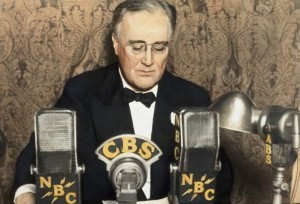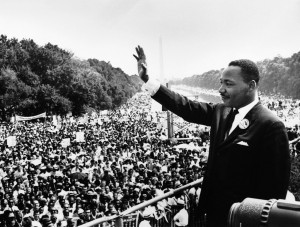FEAR
I’ve been thinking about what a potent force fear is, particularly from the point of view of leadership. What leaders decide to do with and about fear in their people is one of the most important distinguishing qualities of a leader, and one of the first choices we must make. It very quickly establishes the style and flavor of leadership.
 One choice is to play into–and therefore maximize–fear in the people we lead. Adolf Hitler was perhaps a striking example of this sort of leader, along with Pol Pot, Vlad the Impaler, and many leaders of a dictatorial nature. Maximizing fear, inducing a heightened state of fear we describe as “terror,” is one of the ways you can mobilize forces as a leader. You can motivate people to accomplish things using fear. It is also an excellent method for gaining and maintaining control over a group of people.
One choice is to play into–and therefore maximize–fear in the people we lead. Adolf Hitler was perhaps a striking example of this sort of leader, along with Pol Pot, Vlad the Impaler, and many leaders of a dictatorial nature. Maximizing fear, inducing a heightened state of fear we describe as “terror,” is one of the ways you can mobilize forces as a leader. You can motivate people to accomplish things using fear. It is also an excellent method for gaining and maintaining control over a group of people.
Maximizing fear is a strategy that presumes people will be submissive; in the face of terror, people will give up hopes, expectations, even civil rights, because the fear of loss of life trumps those considerations. Leaders who maximize fear are betting that people will become less powerful, and thus more manageable, in the face of it. They use fear to ensure the success of their leadership, rather than the success of their people.
 Then there are examples of leaders who try, instead, to minimize or eliminate fear in the populations they lead. Famously, FDR’s line, “the only thing we have to fear is: fear itself,” pretty much lays out that philosophy. There are numerous examples of leaders who led groups of people straight into the face of what appeared to be formidable opponents (Martin Luther King Jr., or Ghandi, for example) who consciously downplayed fear. It was part of their leadership style to appeal to that part of us which is not afraid, even when confronted by an opponent who tries to frighten us.
Then there are examples of leaders who try, instead, to minimize or eliminate fear in the populations they lead. Famously, FDR’s line, “the only thing we have to fear is: fear itself,” pretty much lays out that philosophy. There are numerous examples of leaders who led groups of people straight into the face of what appeared to be formidable opponents (Martin Luther King Jr., or Ghandi, for example) who consciously downplayed fear. It was part of their leadership style to appeal to that part of us which is not afraid, even when confronted by an opponent who tries to frighten us.
Imagine if FDR had gotten on the radio and wrung his hands, saying, “oh my God we’re all going to die!” You can imagine the impact that might have had on the American radio audience. Rather than the stabilizing, hope-generating response which his leadership brought, people might have been brought to panic in the streets. Or if Kennedy, during the Cuban Missile Crisis (which brought us, arguably, as close as we have ever come to a nuclear exchange) had gotten on the television and said, “My Fellow Americans, we are within mere minutes of being vaporized,” that wouldn’t have been such a great idea. His approach during that time was to try to contain and minimize fear, taking a posture that said, in effect, “the situation is very serious, but we have a plan; the American people are great, and we will prevail.” Leaders who minimize fear are betting that people will become more powerful, and thus more successful, in the face of it. They are betting that the success of their leadership depends on the greatness of their people, not themselves.
 Leaders have to choose to either minimize or maximize the fear response. The choice is either to appeal to the smallest, most constricted, most cynical part of each human being, or to appeal to the highest, most expansive, most altruistic piece in each of us. While it’s an oversimplification, leaders who maximize fear are hoping to get the worst out of everyone. Hitler succeeded in getting each person to bring forth their worst, their most hateful self possible, while leaders who minimize fear often not only bring out greatness in their people–they seem to be able to appeal to the best in their opponents as well. Martin Luther King Jr. not only found a way to empower his own group; he simultaneously appealed to the best in people outside that particular group.
Leaders have to choose to either minimize or maximize the fear response. The choice is either to appeal to the smallest, most constricted, most cynical part of each human being, or to appeal to the highest, most expansive, most altruistic piece in each of us. While it’s an oversimplification, leaders who maximize fear are hoping to get the worst out of everyone. Hitler succeeded in getting each person to bring forth their worst, their most hateful self possible, while leaders who minimize fear often not only bring out greatness in their people–they seem to be able to appeal to the best in their opponents as well. Martin Luther King Jr. not only found a way to empower his own group; he simultaneously appealed to the best in people outside that particular group.
I’ve given only dramatic examples of both here, but this decision as to whether to play into or away from people’s fears shows up in little ways all the time. Take our election process, for example. My sense is that a considerable amount of effort in both major parties, both Republicans and Democrats, is spent trying to access and maximize people’s fears: “vote for me, or the worst will happen.”
 So, after months of communication from leaders who want to appeal to our fears, is it any surprise that many of us don’t really enjoy the process leading up to the election, and feel a sense of relief when it’s over? When someone appeals to your fears, they invite you to become smaller and more constricted. And my experience of the election process and debate rhetoric in this country is that I feel diminished. I feel smaller coming out of that experience than I did going into it, and the reason is that when we appeal to people’s fears, we invite them to contract, and they often accept the invitation.
So, after months of communication from leaders who want to appeal to our fears, is it any surprise that many of us don’t really enjoy the process leading up to the election, and feel a sense of relief when it’s over? When someone appeals to your fears, they invite you to become smaller and more constricted. And my experience of the election process and debate rhetoric in this country is that I feel diminished. I feel smaller coming out of that experience than I did going into it, and the reason is that when we appeal to people’s fears, we invite them to contract, and they often accept the invitation.
One of the greatest thing leaders can do for their people, if they want to maximize their people rather than merely control them, is to acknowledge, contain and minimize fear. I’m not talking about suppressing what we feel; it’s important to be able to say, “ok, I realize this might seem scary, and I understand that many of us are afraid right now.” But it’s also important to follow with some form of “but I know we can get through this, and here’s why.”
The historical accounts of Jesus, as I read them, point towards this style of leadership. A striking number of times, Jesus said, in one way or another, “listen: don’t be afraid. Don’t be afraid if they mock you; don’t be afraid if they scorn you, don’t even be afraid if they put you to death.” He encouraged, and inspired, large numbers of folks who were able to aspire to their highest selves and to remain self-confident, and relatively calm and focused, even as they were doing difficult, even fatal, things with their lives.
 Speaking of leaders, the way we form our concept of “God” or a higher power/force largely falls down around the same dividing lines: is God primarily a force to be feared, a being or belief that increases fearfulness and maximizes the amount of terror we feel in life? Or is this a force that allows us to be calm in the face of danger, confident, relaxed, knowing that whatever faces us, we are able to access a powerful and strong resource to engage what’s ahead?
Speaking of leaders, the way we form our concept of “God” or a higher power/force largely falls down around the same dividing lines: is God primarily a force to be feared, a being or belief that increases fearfulness and maximizes the amount of terror we feel in life? Or is this a force that allows us to be calm in the face of danger, confident, relaxed, knowing that whatever faces us, we are able to access a powerful and strong resource to engage what’s ahead?
Do we live our lives primarily to avoid the tortures of hell, or do we live life by consistently moving towards love? These are two fundamentally different, even opposite, approaches, derived from whether we opt to maximize or minimize fear as a driving force. The first posture encourages us to contract, and the second posture encourages us to open. The first encourages black-and-white, yes-or-no, in-or-out thinking, “checklist answers” to complicated questions, while the second exponentially increases the complexity of the questions, making many of them unanswerable. We simply have to continue to open and live into the mystery.
Unless they’re really paying attention, one of the unfortunate things leaders do is send signals to their followers that discourage people from disagreeing with the leader. The message might be, “be as open minded as you like, believe anything, unless, of course, it differs from what I think you should believe.” Leaders have subtle ways of making people afraid to disagree with them. We can withhold affection, for example, a very subtle thing that encourages people to be afraid. The covert message is, “unless you see things the way I see them, I might not like you as much.”
 Leaders will often unconsciously condition their people to avoid giving certain kinds of feedback (for example: criticisms or suggestions for improvement.) We can sometimes find a subtle way to send the message, “please don’t bring anything to my attention that might be inconvenient for me to hear.” The way we do that is by unconsciously appealing to fear: “you’ll be an outcast, you’ll lose my affection, I won’t call on you the next time we need a committee chair, you won’t be in the ‘inner circle’ anymore,” etc. “Tell me something I don’t want to hear, and I’ll make sure it’s unpleasant for you so that you won’t do it very often.”
Leaders will often unconsciously condition their people to avoid giving certain kinds of feedback (for example: criticisms or suggestions for improvement.) We can sometimes find a subtle way to send the message, “please don’t bring anything to my attention that might be inconvenient for me to hear.” The way we do that is by unconsciously appealing to fear: “you’ll be an outcast, you’ll lose my affection, I won’t call on you the next time we need a committee chair, you won’t be in the ‘inner circle’ anymore,” etc. “Tell me something I don’t want to hear, and I’ll make sure it’s unpleasant for you so that you won’t do it very often.”
This is something we have to be aware of in Touch Practice. If we are to fully hold each other, to hold each other as we are, to hold each other unconditionally and without “strings,” letting go as freely as we embrace, then we have to hold space for the people we hold to be able to move towards or away from us, physically and ideologically.
While of course I always LOVE (hear that word in Barry White’s voice to get the full impact) hearing that people think Touch Practice is the greatest thing since sliced bread, I have to preserve space for the people I hold to have other reactions to it. Now I’m not aware of anyone who intensely dislikes Touch Practice, to be honest, but I am certainly aware of some people who have mixed reactions, or who have been held and thought, “eh, not such a big deal, not life changing” and so forth.
What I pay acute attention to in those moments is my own feelings: do I contract in fear or with a sense of rejection when I encounter those reactions, or do I keep myself fully available and fully open to that person? Can I continue to focus on what attracts me to them even in those moments? Am I encouraging the person to continue to open, to continue to be unafraid, even when they are criticizing me? If I can stay fully engaged with them, even if they don’t think much of the work, even if they don’t like me, if I can continue to leave my arms open and sit with them where they are, that’s it: that’s Touch Practice, as I understand it. That’s what “I hold whomever shows up” looks like in action. (This is easier to say than to do. I can’t always get there, but most of the time, if I try, I can at least make it most of the way.)
Much as I revel in the sense of comradeship and real brotherhood that permeates the Touch Practice community, and much as I love the affection that we lavish on each other, Touch Practice is, and must be, more than a mutual adoration society. (I love being adored, don’t get me wrong.) But we are each unique, we walk on many different paths and we carry many different practices.
 The ultimate invitation we can give to each other that says “don’t be afraid” comes down to a personal level. It is a posture which says, in effect: “Don’t be afraid to disagree with me; don’t be afraid to dislike me, don’t be afraid to be different from, or opposite from, me. These arms are open anyway. You won’t lose my affection because you disagree with me.”
The ultimate invitation we can give to each other that says “don’t be afraid” comes down to a personal level. It is a posture which says, in effect: “Don’t be afraid to disagree with me; don’t be afraid to dislike me, don’t be afraid to be different from, or opposite from, me. These arms are open anyway. You won’t lose my affection because you disagree with me.”
The gesture in Jesus’ language is “bless those who persecute you.” Now, that’s a bit ridiculously strong for Touch Practice; I don’t know anyone who has ever been persecuted because of this work. I’ve been teased and mocked a bit online by cynical people, but that’s quite mild, really.
I do know in welcoming many different communities of men, some of whom are afraid, some of whom are aggressive, some of whom have judgments against each other, that there’s a choice to be made between maximizing fear between men, or finding a way to say, “hey, listen. Don’t be afraid. There’s a higher part of each of us available. Let’s find it, and go there.”
Have thoughts you’d like to share?
Touch Practice is a sacred practice for me, and part of that is keeping confidences sacred. While a name and e-mail address are required to post a comment, feel free to use just your first name, or a pseudonym if you wish. Your e-mail address will never be seen by or shared with anyone. It is used to prevent spam and inappropriate comments from appearing in the blog. I’d really like to hear from you!













